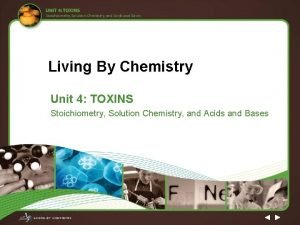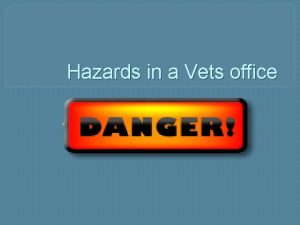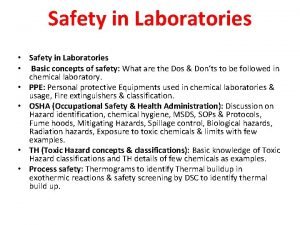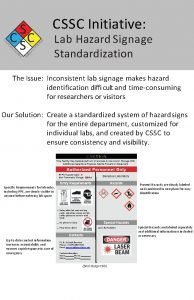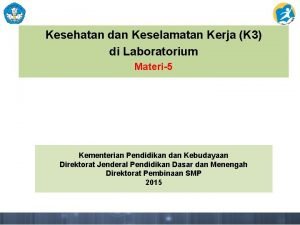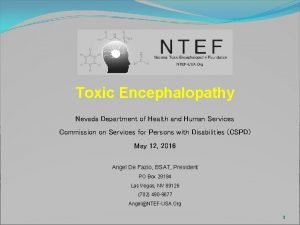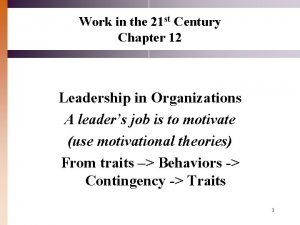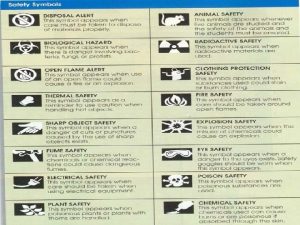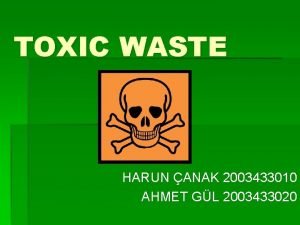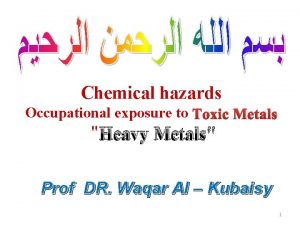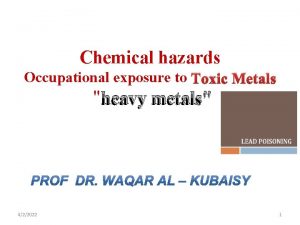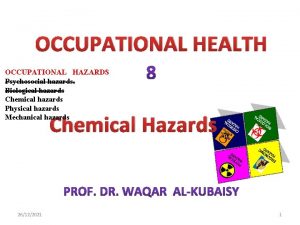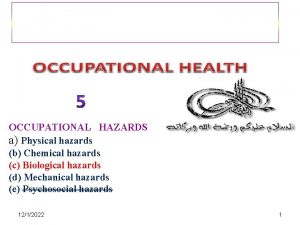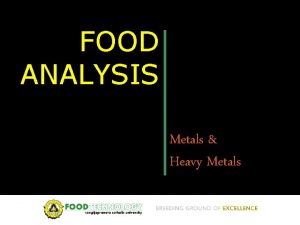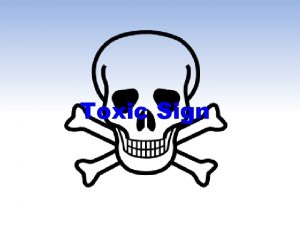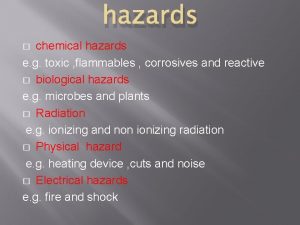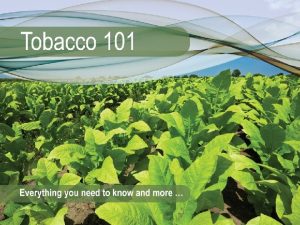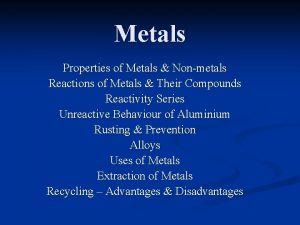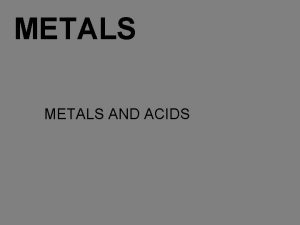Chemical hazards Occupational exposure to Toxic Metals Heavy




































- Slides: 36

Chemical hazards Occupational exposure to Toxic Metals " Heavy Metals" Prof DR. Waqar Al – Kubaisy 1

Toxic Metals, q Toxic metals, including "Heavy Metals, " are individual metals and metal compounds v that negatively affect people's health. v In very small amounts, many of these metals are necessary to support life. v However, in larger amounts, they become toxic. q They may build up in biological systems and become a significant health hazard.

Most hazardous: Lead Mercury Arsenic Cadmium Beryllium Hexa-valent Chromium Other toxic metals: § Aluminum • Antimony • Cobalt • Copper • Iron • Manganese • Molybdenum • Nickel • Selenium • Silver • Tin • Vanadium • Zinc

LEAD POISONING CONTENTS • Source & Uses • Body stores & Distribution • Lead poisoning • Clinical features • Diagnosis • Management • Prevention

Lead exposure: Lead over exposure is one of the most common overexposures found in industry and is a leading cause of workplace illness. Therefore, OSHA (The Occupational Safety and Health Administration, a branch of the US Department of Labor) has established (recognized) the reduction of lead exposure to be a high strategic priority. OSHA's five year strategic plan q sets a performance goal of a 15% reduction in the Ø average severity of lead exposure or Ø employee blood lead levels in selected industries and workplaces. Lead poisoning in population

q lead may be present in hazardous concentrations in Ø food, water, and air. v Sources include paint, urban dust, and folk remedies v Lead poisoning is also a major potential public health risk In general populations, v Lead poisoning is the leading environmentally induced illness in children. v children under the age of six are at greatest risk, Ø because they are undergoing rapid neurological and physical development Lead dust or fumes are inhaled, or is ingested via contaminated hands, food, water, cigarettes or clothing. Lead entering the respiratory

. v Ø q Ø Lead exposure: Lead entering the respiratory and digestive systems is released to the blood and distributed throughout the body. More than 90% of the total body burden of lead is accumulated in the bones, where it is stored. Lead in bones may be released into the blood, re-exposing organ systems long after the original exposure. BODY STORES : § Normal adults ingest about 0. 2 to 0. 3 mg of lead /day § largely from food and beverages • The body store of lead in the average adult population is about 150 to 400 mg and • blood levels average about 25μg/100 ml. • An increase to 70μg/100 ml blood is generally associated with clinical symptoms.

MODE OF ABSORPTION : Lead poisoning (Plumbism ) may occur in three ways: (1)INHALATION: Most cases of industrial lead poisoning is due to inhalation of fumes and dust of lead or its compounds. (2) INGESTION: Poisoning by ingestion is of less common occurrence. • Small quantities of lead trapped in the upper respiratory tract may be ingested. • Lead may also be ingested in food or drink through contaminated hands. (3) SKIN : Absorption through skin occurs only in respect of the organic compounds of lead, especially tetraethyl lead. Inorganic compounds are not absorbed through the skin

Lead absorption Skin: little/no absorption Inhalation (<1µm): dust or lead fumes absorb 50 70% Oral: adults absorb 10% children absorb 40 50% increased absorption if low Fe, Ca

DISTRIBUTION IN THE BODY: q 90% of the ingested lead is excreted in the faeces. v Lead absorbed from the gut enters the circulation, and v 95 % enters the erythrocytes. v It is then transported to the LIVER and KIDNEYS and finally v transported to the BONES where it is laid down with other minerals. q Although bone lead is thought to be 'metabolically inactive', v it may be released to the soft tissues again under conditions of bone resorption. v Lead probably exerts (utilizes) its toxic action by combining with essential v SH-groups of certain enzymes, for example some of those involved in prophyrin synthesis and carbohydrate metabolism. q Lead has an effect on membrane permeability and q potassium leakage has been demonstrated from erythrocytes exposed to lead



What Lead Levels Are Considered Elevated in Adults? v At levels above 80 μg/d. L, serious permanent v health damage may occur (extremely dangerous). v Between 40 and 80 μg/d. L, serious health damage may be occurring, even if there are no symptoms (seriously elevated). v Between 25 and 40 μg/d. L, regular exposure is occurring. There is some evidence of potential physiologic problems (elevated). v Between 10 and 25 μg/d. L, lead is building up in the body and some exposure is occurring. v for U. S. adults The typical level is less than 10 μg/d. L (mean = 3 μg/d. L).

What Lead Levels Are Considered Elevated in Adults?

SOURCE & USES • Lead(Pb) is a heavy metal • Occupational & Non-occupational sources • Main source of environmental (non-occupational)source of Pb is Gasoline • Also through drinking water from lead pipes, chewing lead paints on toys etc. . § More industrial workers are exposed to lead than to any other toxic metal. Lead is used widely in a variety of industries because of its properties: ( (1) low boiling point (2) mixes with other metals easily to form alloys ﺳﺒﺎﺋﻚ (3) easily oxidised and (4) anticorrosive.

LEAD POISONING(PLUMBISM) All lead compounds are toxic v MOST Dangerous NON-OCCUPATIONAL SOURCES lead arsenate, • The greatest source of lead oxide and environmental (non-occupational) lead carbonate; lead is gasoline. v the least toxic is lead sulphide • Thousands of tons of lead every year is exhausted from INDUSTRIAL USES : automobiles. Over 200 industries are • Lead exposure may also occur counted where lead is used through drinking water from § manufacture of storage • lead pipes; batteries • chewing lead paint on window sills § glass manufacture; ﻋﺘﺒﺎﺕ ﺍﻟﻨﺎﻓﺬﺓ or toys in case of children. § ship building; § printing and potteries; § rubber industry and several others

CLINICAL PICTURE : The clinical picture of lead poisoning or plumbism is different in the inorganic and organic lead exposures. CLINICAL FEATURES Inorganic Pb exposure: § Abd. Colic § obstinate constipation § loss of appetite § blue lines on gums § stippling of red cells § anaemia § wrist drop foot drop Organic Pb compounds: (toxic effect mainly on CNS) • Insomnia • Headache • Mental confusion • Delirium etc. .

Acute lead poisoning Clinical picture v (as short as days) Long term Ø loss of appetite, v (chronic: as long as several years) Ø nausea, result in severe damage to the Ø vomiting, Ø blood-forming, Ø stomach cramps, Ø nervous, Ø constipation, Ø urinary, and Ø difficulty in sleeping, Ø reproductive systems. Ø fatigue, v The frequency and severity of Ø moodiness, medical symptoms increases with Ø headache, the concentration of lead in the Ø joint or muscle aches, blood Ø anemia, and Ø decreased sexual drive. v Acute health poisoning from uncontrolled occupational exposures has resulted in fatalities.

Key lead-induced health effects.


DIAGNOSIS Diagnosis of lead poisoning is based on : § History § Clinical featuressuch as loss of appetite, intestinal colic, persistent headache, weakness, abdominal cramps and constipation, joint and muscular pains, blue line on gums, anaemia, etc. § Laboratory diagnosis a) Coproporphyrin in urine(CPU) Measurement of CPU is a useful screening test. In non exposed persons, it is less than 150 microgram/litre. Normal- <150µg/L b)Amino levulinic acid in urine(ALAU) >5 mg/L it indicates clearly lead absorption. Pb in blood and urine

Cont. . . Diagnosis c) Pb in blood and urine They provide quantitative indicators of exposure (In urine Nl is 0. 2 -0. 8 mg) In urine- >0. 8 mg/L indicates lead exposure and lead absorption In blood- >70µg/100 ml Pb absorption is associated with clinical symptoms d) Basophilic stippling of RBC: Is a sensitive parameter of the haematological response.

MANAGEMENT : v The major objectives in management of lead poisoning are the Ø prevention of further absorption, Ø the removal of lead from soft tissues and Ø prevention of recurrence. Ø Early recognition of cases will help in removing them from further exposure. Ø Ø TREATMENT A saline purge will remove unabsorbed lead from the gut. The use of d-penicillamine has been reported to be effective. chelating agent Like Ca EDTA, it is works by promoting lead excretion in urine. lead poisoning is a notifiable and compensatable disease in India since 1924.

What Are the Treatment Issues to Be Considered For Adults? q When lead poisoning has been diagnosed, q the first course of action is to discontinue exposure. Whether discontinuation of exposure is sufficient to treat depends on: Ø *the blood lead level, Ø **severity of clinical symptoms, Ø *** biochemical and hematologic disturbances, Ø ****the nature and history of exposure. All of these factors must be considered in determining the necessity for chelating therapy. q There is no exact blood lead concentration above which treatment with a chelating agent is always indicated. v In most cases, however, when a blood lead level RISES TO 80 μg/d. L, CHELATION SHOULD BE CONSIDERED, especially in the presence of more severe signs and symptoms

Treatment: Chelating agents for lead poisoning: 1. EDTA - Sodium calcium edetate 2. DMSA – Dimercapto-succinic acid 3. BAL - Dimercaprol Remember: 4. Penicillamine - no longer recommended The exposure must first EDTA - Sodium Calcium Edetate be discontinued before IV for severe toxicity, initiating chelation particularly encephalopathy therapy. Well tolerated, <1% nephrotoxicity DMSA - 2, 3 dimercaptosuccinic acid The oral agent of choice for lead poisoning Given as a 19 day course Well tolerated The main problem is foul taste and smell !! Therapeutic chelating agents have potentially adverse side effects and should be used carefully and on an individual basis

Cont. . . Chelating agents A single course of chelation may not sufficiently reduce blood lead levels and repeat courses may be required among heavily exposed individuals. How to reduce exposure? ØWash hands and face before eating, drinking or smoking. ØEat, drink and smoke only in areas free of lead dust and fumes. ØStore food and tobacco in clean areas. ØWear a clean, properly fitted respirator in all areas that have lead dust or fumes. ØChange into different clothes and shoes before engaging in work with lead. ØKeep street clothes and shoes in a clean place. ØShower after working with lead before going home. ØLaunder clothes separately from other family members’ clothes

PREVENTIVE MEASURES The most effective way to protect workers is to minimize their exposure through: Øengineering controls, Øgood work practices and training, Øthe use of personal protective clothing and equipment, including respirators, where required. Engineering controls include: 1)material substitution, 2)isolation, 3)process/equipment modification 4)local ventilation.

Cont. . . PREVENTIVE MEASURES a) Substitution Pb compounds should be substituted by less toxic materials b) Isolation All processes which give rise to harmful concentration of pb dust or fumes should be enclosed and segregated c) Local exhaust ventilation There should be adequate local exhaust ventilation system To remove dust & fumes d) Personal protection By approved respirators e) Good housekeeping is essential where lead dust is present. Floors, benches, machines should be kept clean by wet sweeping f) In working atmosphere Pb conc. Should be kept <2 mg per 10 cu. m of air which is usually the permissible limit or threshold value

Cont. . . PREVENTIVE MEASURES g) Periodic medical examination of workers. All workers must be given periodical medical examination. Ø Laboratory determination of and Ø urinary lead, Ø coproporphyrin test of urine Ø blood lead, should be done periodically. Ø red cell count, Ø Estimation of basophilic stippling Ø haemoglobin estimation may also be done h) Personal hygiene (Hand washing) before eating is an important measure of personal hygiene. Ø There should be adequate washing facilities in industry. Ø Prohibition on taking food in work places is essential i) Health education Workers should be educated on the risks involved and personal protection measures WHO states

Cont. . . PREVENTIVE MEASURES WHO states that in the case of exposure to lead, it is not only the average level of lead in the blood that is important, but also the number of subjects whose blood level exceeds a certain value. e. g. , 70μg/ml or whose ALA in the urine exceeds 10 mg/litre) 1) 2) 3) 4) 5) Some fundamental and easily implemented work practices are: good housekeeping, appropriate personal hygiene practices Periodic inspection and maintenance of process and control equipment, proper procedures to perform a task, appropriate supervision to ensure that the proper procedures are followed.

I. Guidelines for the Control of Lead in the Workplace q. First, test each worker before they begin any work involving lead q. Then test that worker every month: ØFor the first 3 months of testing, and ØWhenever the previous blood lead level was greater than 25 μg/d. L (If the previous blood lead level was at least 50 μg/d. L, Øa follow-up test within 2 weeks and medical removal is required), or ØWhenever an increase of at least 10 μg/d. L from the previous test is observed

II. Voluntary Guidelines for the Control of Lead in the Workplace q. After the first three months, continue testing every 2 months: ØWhen the blood lead levels have remained below 25 μg/d. L for 3 months, and ØIf an increase less than 10 μg/d. L from the previous test is observed q. Test every 6 months: ØWhen the blood lead levels remain below 25 μg/d. L for 6 mths, & ØIf an increase less than 10 μg/d. L from the previous test is observed q. Results of each test should be provided to the worker. q. Tracking the test results can help the employer and the worker identify whether blood lead levels are Ø dropping, The employer should also review the test Ø remaining stable or results for all workers to help identify jobs where problems may be occurring Ø increasing.

Voluntary Guidelines for the Control of Lead in the Workplace If you see a case of lead poisoning or overexposure, there may be more nearby! Find out if there are other adults or children who are being exposed at work or at home

Thank you for attention 5 th Annual Global Healthcare Conference 34


The nucleated RBCs contain basophilic stippling of the cytoplasm. This suggests a toxic injury to the bone marrow, such as lead poisoning. Such stippling may also appear with severe anemia, such as a megaloblastic anemia.
 How to manage economic exposure
How to manage economic exposure Managing economic exposure and translation exposure
Managing economic exposure and translation exposure Managing economic exposure and translation exposure
Managing economic exposure and translation exposure Operating exposure vs transaction exposure
Operating exposure vs transaction exposure Shratey
Shratey Toxic reactions chemical equations
Toxic reactions chemical equations Toxic reactions chemical equations
Toxic reactions chemical equations Metals and non metals
Metals and non metals Grade 7 ns term 2 worksheets
Grade 7 ns term 2 worksheets Periodic table with metals and nonmetals
Periodic table with metals and nonmetals Natural science grade 7 lesson plans term 2
Natural science grade 7 lesson plans term 2 Examples of alloy metals
Examples of alloy metals Metals examples
Metals examples Chemical hazards in a veterinary clinic
Chemical hazards in a veterinary clinic Reactivity of group 1
Reactivity of group 1 Fgc toxic
Fgc toxic Toxic relatiinship
Toxic relatiinship Health hazard symbol
Health hazard symbol Toxic multinodular goiter
Toxic multinodular goiter Toxic substances control
Toxic substances control Toxic friendships
Toxic friendships Fimmta veikin
Fimmta veikin Toxic leadership styles
Toxic leadership styles Schoolofeducators
Schoolofeducators Toxic trio safeguarding
Toxic trio safeguarding Unhealthy communication
Unhealthy communication Very toxic
Very toxic Non toxic ceramic paint
Non toxic ceramic paint Toxic popcorn challenge solution
Toxic popcorn challenge solution Unhealthy relationship scenarios
Unhealthy relationship scenarios Acute toxic encephalopathy icd 10
Acute toxic encephalopathy icd 10 Toxic triangle of destructive leadership
Toxic triangle of destructive leadership How toxic is bracken fern
How toxic is bracken fern Toxic
Toxic Double positive t cells
Double positive t cells Toxic waste causes
Toxic waste causes What causes central hypothyroidism
What causes central hypothyroidism





